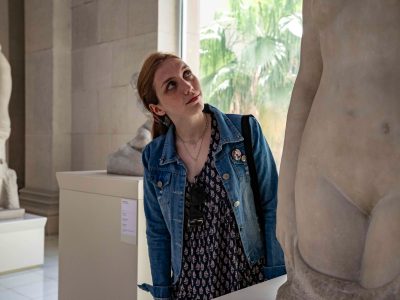
Miró and Picasso: a personal and artistic friendship
Miró–Picasso (19 October-25 February 2024) is a joint exhibition featuring pieces by Miró and Picasso across two sites: the Miró Foundation and the Barcelona Picasso Museum. It unpacks the friendship between the two artists, their similarities and their artistic journey together with their relationship with the city of Barcelona, including the establishment of their own museums. One of the key aspects is how they influenced each other.
Miró and Picasso shared the same spirit of freedom and transgression which led them to explore the limits of painting. Even though they were two different artists, they also shared an interest in poetry and writing and discovered ceramics as a means of expression. Their friendship was extremely close from 1920 onwards and lasted until the end of their lives.
An exceptional exhibition
It is an exceptional event for two reasons: because it is the first time it has been hosted in Barcelona and because never before have so many of the two artists’ original works been brought together in the same city. These pieces come from the world’s leading collections and many are from the Musée Picasso in Paris.
The exhibition is an instance of close partnership between the two host venues. A case in point is how they have exchanged works. For example, the Las Meninas painting will leave the Picasso Museum to be displayed at the Joan Miró Foundation over the months the exhibition lasts. Meanwhile the Foundation is to loan L’estel matinal (Morning Star), a key piece in Miró’s artistic career, to the Picasso Museum.
A tribute to Barcelona
The Miró-Picasso exhibition is also a tribute to the city of Barcelona. It is divided into six areas, the layout is practically the same in both museums and the works are split across the Barcelona Picasso Museum and the Joan Miró Foundation. These two complementary exhibitions can be visited in any order.
1. The Encounter
Barcelona 1917: Picasso at the Gran Teatre del Liceu
The exhibition tour begins in 1917, a crucial year for the two artists. The Russian ballet Parade was staged at the Gran Teatre del Liceu in Barcelona featuring sets devised by Picasso in which he combined synthetic Cubism with classicising figuration. This work had such an impact on the young Miró that he gave up his eclectic style to experiment with Cubism, Oriental art and Gothic painting. He withdrew to his studio in Mont-roig del Camp to hone his new, more detailed technique.
Pieces from this period such as Miró’s El cavall, la pipa i la flor vermella (Horse, Pipe and Red Flower) and Picasso’s Arlequí (Harlequin) can be seen at the Joan Miró Foundation.
Paris 1921: Miró at La Licorne gallery
In 1921, Miró went to Paris for the first time where he planned to arrange his first solo exhibition. He often called in on Picasso who showed great interest in his work and gave him good advice and support. When Miró opened his exhibition at La Licorne gallery, Picasso bought one of the paintings on display entitled Autoretrat (Self-Portrait).
This work and La masia (The Farmhouse) by Miró are on show at the Barcelona Picasso Museum.
2. The Paris of Surrealism
The impact of the Mercure ballet
In 1924, the avant-garde ballet Mercure premiered at the Théatre de la Cigale in Paris. Picasso designed the sets as he had done with Parade, but this time shifting away from the Cubist and neoclassical aesthetics of the previous years. He combined image, signs and writing, a new visual art which thrilled the Surrealists. Miró also attended the show which enthralled him. This spellbinding fascination cemented his new artistic approach based on the linearity of drawing with minimal visual resources.
The paintings Teló per a ballet “Mercure” (Drop curtain for the “Mercure” ballet) by Picasso and Pintura (El català) (Painting (The Catalan)) by Miró are on show at the Barcelona Picasso Museum.
An unprecedented Picasso
In 1925, Miró came into contact with the Surrealist movement and created highly synthetic works pared down to simple lines and patches of colour. Meanwhile, Picasso reinvented himself and kicked off a new style which he announced with the painting Les tres ballarines (The Three Ballerinas) in 1925 featuring more distorted forms. Both artists began to experiment with the female figure.
The Joan Miró Foundation is showing the paintings Retrat d’una ballarina (Portrait of a Ballerina) by Miró and Les tres ballarines (La dansa) (The Three Ballerinas (The Dance)) by Picasso.
Forms of desire
Both artists are associated with the Surrealist movement led by André Breton but neither was ever an official member of it. Miró plunged into poetry to break away from all pictorial convention. Picasso, by contrast, explored the visual limits of art with contorted, clearly sexual and disturbing shapes which shock the viewer, one of the goals pursued by Surrealism.
Picasso’s Gran nu en una butaca vermella (Large Nude in Red Armchair) and Miró’s Flama en l’espai i dona nua (Flame in Space and Nude Woman) are on display at the Barcelona Picasso Museum.
Challenging painting
In 1927, Miró said he wanted to ‘murder’ painting and turned to collage, just as Picasso had done a year earlier with his piece Guitarres (Guitars). In 1930, they both took part in the group exhibition of collages at the Galerie Goemans in Paris called La Peinture au défi. Miró presented two Spanish Ballarines (Ballerinas) and a collage, Picasso six collages, including one of his Guitarres made of hessian and nails.
At the Joan Miró Foundation you can see Miró’s L’objecte de la posta de sol (Object of Sunset) and Picasso’s La noia (The Girl).
3. Painting and PoetryJarry’s universe
Multifaceted and eccentric writer Alfred Jarry shook up the late 19th century Parisian scene with the play Ubu Roi (Ubu King) which laid the foundations for the theatre of the absurd. This writer influenced both Miró and Picasso. Miró produced a number of artist’s books with drawings entitled Ubu roi (1966), Ubu aux Baléares (1971) and L’Enfance d’Ubu (1975). Picasso constructed several versions of Ubu in works such as Cap (Head) and Banyista en una cabina de bany (Bather and Cabin).
Picasso’s Cap and Miró’s Ubu Roi can be seen at the Barcelona Picasso Museum.
The poet friends
Miró’s and Picasso’s graphic works are artist’s books, the upshot of their interest in poetry. This literary genre enabled them to embark on new creative adventures which overstepped the traditional boundaries between the arts. Both artists paid tribute with their books to poet friends such as Paul Eluard and also addressed the same text, L’Antitête by Tristan Tzara.
The illustrated books Poésie des mots inconnus by both Picasso and Miró can be seen at the Barcelona Picasso Museum.
Poetic art, artistic poetry
Miró and Picasso reflected in their output the dialogue between the word and the pictorial brushstroke. They also pursued their own poetic activity. Picasso began depicting words in his paintings in 1935, first in Spanish and then in French. Miró started to write long poetic texts in 1936. His style is akin to Dadaism and Surrealism and inspired by Alfred Jarry’s erotic and coarse humour.
The painting Escargot, femme, fleur, étoile by Miró and the print Poemes i litografies (Poems and Lithographs) by Picasso are on show at the Joan Miró Foundation.
4. Years of War
The Spanish Civil War
On the outbreak of the conflict in 1936, both artists sided with the Government of the Republic which on the strength of their international standing invited them to the Paris International Expo of 1937. Picasso painted Guernica and Miró El segador (The Reaper) directly on the pavilion’s walls. Miró’s work was destroyed when the pavilion was dismantled while Picasso’s piece toured Europe and America to raise funds in support of the Republican cause. In the Civil War, Picasso painted pictures using photographer Dora Maar as a model while Miró sidestepped the moment by creating his own language of signs.
Miró’s painting Sense títol (Cap d’home) (Untitled (Head of a Man)) and Picasso’s La dona que plora (The Weeping Woman) date from this period and are on show at the Joan Miró Foundation.
The Second World War
The outbreak of the war in September 1939 was a turning point in artistic terms for these geniuses. From then on their paths began to diverge. Miró fled from reality and invented a new language with signs and symbols to begin the series of twenty-three Constel·lacions (Constellations) which he completed in Mont-roig del Camp in 1941. Picasso addressed the conflict in an expressive style featuring still lifes and animal and other skulls which evoke the fleeting nature of life.
5. From the Murder of Painting to Ceramics
Picasso presented his collection of 446 ceramics pieces in 1948 accompanied by Miró. The latter wrote a special text to go with it: “De l’assassinat de la peinture à la céramique… comme la céramique de Picasso” (From the Murder of Painting to Ceramics like Picasso’s), a reflection on the dismantling of the boundaries between manual arts and poetry. The two artists learned the basics of the craft in the workshop and created decorative pieces, tableware, sculptures and ceramic murals.
Picasso’s ceramic El mussol (Owl) and Miró’s Dona (Woman) figure are on display at the Barcelona Picasso Museum.
6. Picasso’s Style, Miró’s Language
Revisions
Picasso painted a series of fifty-eight oils about Velázquez’s Las Meninas in 1957. In these revisions of this universal work he scrutinised the environment of the art of painting. In the late 1920s, Miró was inspired by the Flemish 17th century masters and Raphael’s La Fornarina (The Portrait of a Young Woman) to question painting. In the late 1930s, his reference point was prehistoric art which he used to put together his own language of signs. He drew on this simple language to revisit the work he had left unfinished during the war.
At the Joan Miró Foundation you can see the paintings La Fornarina (D’après Raphaël) (La Fornarina (After Raphael)) by Miró and Las Meninas by Picasso.
Public and monumental art
After the war, public spaces were made more human with artworks. In 1955, UNESCO chose eleven artists to decorate its new headquarters in Paris. In collaboration with Josep Llorens Artigas, Miró produced the ceramic murals of the sun and the moon while Picasso created La caiguda d’Ícar (The Fall of Icarus), a painting on forty wooden tiles. In 1963, the two artists fashioned two sculptures for Chicago in the United States. The Richard J. Daley Center sculpture by Picasso was unveiled in 1967 and the monumental version of Miró’s sculpture Lluna, sol i una estrella (Moon, Sun and a Star) was set up in 1981 very close to Picasso’s piece.
The models for Lune, soleil et une étoile (Moon, Sun and a Star) by Miró and the Chicago Richard J. Daley Center sculpture by Picasso are on show at the Joan Miró Foundation.
The final revolt
The approach to reality expressed in painting was one of the big differences between the two artists. Picasso pushed painting to the limit to confront reality while Miró distanced himself from it and sought to go beyond it by creating his own language. Picasso always claimed to be a painter while Miró also claimed to be a poet.
Both were honoured for a lifetime devoted to art. At the age of 90, Picasso specially chose the 400 works which were exhibited at the Palais des Papes in Avignon in 1970 and 1973. In Miró’s case, the Grand Palais in Paris hosted a major retrospective for him in 1974. The 81-year-old Miró was keen for his recent work to have a prominent place in the exhibition.
Picasso’s paintings La familia (The Family) and El pintor i la model (The Painter and the Model) can be seen at the Joan Miró Foundation. Meanwhile, Miró’s Poema III (Poem III) and Tela cremada 1 (Burnt Canvas 1) are on show at the Barcelona Picasso Museum.












